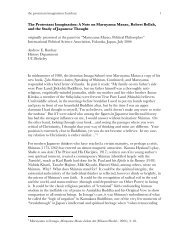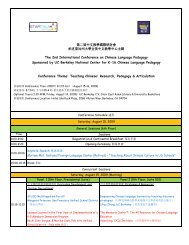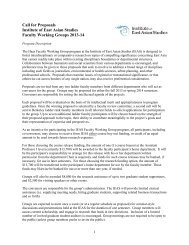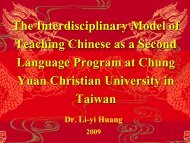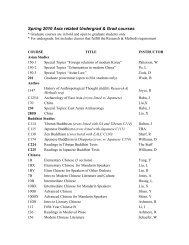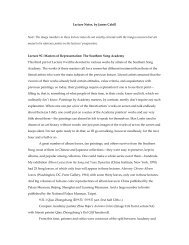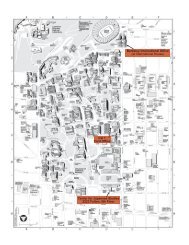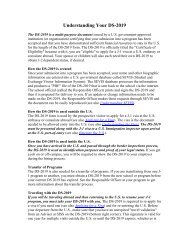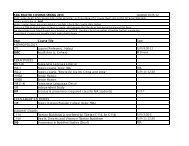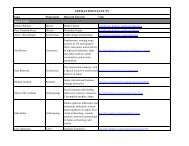Third Edition Spring 2013 - Institute of East Asian Studies, UC ...
Third Edition Spring 2013 - Institute of East Asian Studies, UC ...
Third Edition Spring 2013 - Institute of East Asian Studies, UC ...
Create successful ePaper yourself
Turn your PDF publications into a flip-book with our unique Google optimized e-Paper software.
Maps, Histories, and OwnershipMaps themselves are metaphors: they reveal our orientationto land and water, and convey, through the portrayal <strong>of</strong> boundaries,the underlying organization <strong>of</strong> power over the resourcesthey depict. Often, what is not included reveals as much as what is.Pre-modern Japan’s relationship with the waters that surroundedit could be characterized as ambivalent. On the one hand, theoceans were rich in life-sustaining resources. At the same time, theopen sea was a source <strong>of</strong> great risk and uncertainty. Accordingly,the earliest known maps <strong>of</strong> Japan as a unified realm, from theeighth century, show the three large islands <strong>of</strong> Honshu, Shikoku,and Kyushu surrounded by water. No other lands, such as the Koreanpeninsula, the vast continental China, or the large island to thenorth <strong>of</strong> Honshu known today as Hokkaido, were depicted. In fact,Hokkaido wasn’t included on national maps until the early modernperiod. Though widely considered to be the ancestral home <strong>of</strong>Ainu, Hokkaido is not the only historical Ainu land. In addition toHokkaido, Ainu occupied northern Honshu, the Kuril Islands, andthe disputed island <strong>of</strong> Sakhalin. The necessary simplification <strong>of</strong> informationrequired to create maps demonstrates the difficulty <strong>of</strong>showing a relationship between land and people that extends beyonda single, dominant narrative. By definition, indigenous statuslinks people to land, but at the same time, renders them subject toa defining authority. Maps, in short, reveal an intense ambiguity <strong>of</strong>ownership.The question <strong>of</strong> ownership is similarly applicable to the production<strong>of</strong> historical narratives. Is Ainu history Japanese history?David Howell asks this essential question in his eponymous article.6 Just as maps are ill suited to display conflicting narratives, so,too, are national histories; the power to author one’s own historyis not freely bestowed. Howell states that Ainu history must be toldin the context <strong>of</strong> Japanese history, even though this limits the types<strong>of</strong> questions that can be asked and the ways they can be answered. 7He identifies three barriers preventing the emergence <strong>of</strong> an Ainuhistory apart from Japanese history: 1) The broader acceptance <strong>of</strong>Ainu history within academia; 2) the expansion <strong>of</strong> viable sourcematerials (reflecting a bias against oral tradition within ‘<strong>of</strong>ficial’historical narratives); and 3) the political tensions surrounding thestudy <strong>of</strong> Ainu.In regard to the obstacle <strong>of</strong> acceptance, Howell observesthat, “Ironically, it will be hard for Ainu history to establish itself asa field until historians <strong>of</strong> Japan come to incorporate the Ainu routinelyinto their narratives, for that is the only way to overcome thecurrent near invisibility <strong>of</strong> the Ainu in scholarly discourse.” Speakingto the issue <strong>of</strong> Ainu history as politically fraught, Howell notesthat, “scholars who do not position themselves as impassioned defenders<strong>of</strong> the Ainu risk being tarred as crass assimilationists. This[…] has parallels in the politics <strong>of</strong> indigenous studies elsewhere inthe world. It helps to account for the tendency <strong>of</strong> many studies <strong>of</strong>the Ainu to include denunciations <strong>of</strong> discrimination past and presentas a framing device.” In other words, the present production <strong>of</strong>Ainu history is at once contained by and resistant to a dominantJapanese narrative; as a product <strong>of</strong> resistance, it draws either supportor denial, and thus does not yet ‘exist’ in its own right.Howell overtly suggests a relationship between Ainu history anda broader narrative <strong>of</strong> indigenous colonization that transcends Japan.8 Maps and histories both function as currencies <strong>of</strong> dominantpowers, constructed to convey selective information. Symbolicallycontained within their boundaries, indigenous lands, histories, andthus, people, become enfolded and obscured rather than included,or even identified.Producing Scientific RacismIn 2005, Taro Aso (now the former prime minister <strong>of</strong> Japan,then the internal affairs and communications minister) gave6 David K. Howell, “Is “Ainu History” “Japanese History”?” Journal <strong>of</strong> Northeast<strong>Asian</strong> History Vol. 5:1 (2008): 121-142.7 Ibid.8 Ibid.73 Valerie Black Ainu Indigeneity 74




